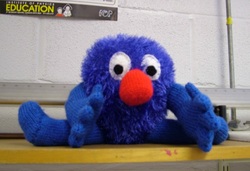A Coulomb

A coulomb is blue and fluffy and goes round with sacks of jewels/joules (missing in photograph)...
Using a blue fluffy coulomb is not as batty as it might at first appear. It gives students a 'thing' to hang the concepts on. And of course they end up designing their own ("Pimp My Coulomb" Thank you @ViciaScience for that). A rather inappropriate student version was Junky Coulomb that smoked a spliff as he went around the circuit; the spliff going down as he went round.
So - The Concepts:
Current
We count coulombs. We think of an ammeter as being a turnstile we've put in the circuit that counts the coulombs as they go THROUGH. How many coulombs go through each second we call amps.
Volts
Coulombs carry jewels/joules. How many joules each coulomb has we call volts.
Complete Circuit
Coulombs only travel in a conga line. There must be one in front and one behind or they cannot move.
Mission
Coulombs have a mission. The power source gives each coulomb some jewels. The coulomb must give away all the jewels before it gets back.
When two conga lines join back together after splitting for parallel routes, they must have equal numbers of jewels left.
You can never lose a coulomb, nor can you magically make one appear.
EMF
The number of jewels/joules given to each coulomb from the power source as they go through.
A coulomb going through two cells in series will collect joules from each cell.
Potential Difference
The difference in the jewels each coulomb has before and after going through a resistance (or its charitable donation)
Voltmeter
A voltmeter spies on the coulombs from outside. It looks to see what jewels/joules are missing from the coulombs bags. I draw it as outside the circuit with two spyglasses focused on two parts of the circuit - this emphasises the voltmeter is parallel, makes a nice V shape and measures the difference.
Using a blue fluffy coulomb is not as batty as it might at first appear. It gives students a 'thing' to hang the concepts on. And of course they end up designing their own ("Pimp My Coulomb" Thank you @ViciaScience for that). A rather inappropriate student version was Junky Coulomb that smoked a spliff as he went around the circuit; the spliff going down as he went round.
So - The Concepts:
Current
We count coulombs. We think of an ammeter as being a turnstile we've put in the circuit that counts the coulombs as they go THROUGH. How many coulombs go through each second we call amps.
Volts
Coulombs carry jewels/joules. How many joules each coulomb has we call volts.
Complete Circuit
Coulombs only travel in a conga line. There must be one in front and one behind or they cannot move.
Mission
Coulombs have a mission. The power source gives each coulomb some jewels. The coulomb must give away all the jewels before it gets back.
When two conga lines join back together after splitting for parallel routes, they must have equal numbers of jewels left.
You can never lose a coulomb, nor can you magically make one appear.
EMF
The number of jewels/joules given to each coulomb from the power source as they go through.
A coulomb going through two cells in series will collect joules from each cell.
Potential Difference
The difference in the jewels each coulomb has before and after going through a resistance (or its charitable donation)
Voltmeter
A voltmeter spies on the coulombs from outside. It looks to see what jewels/joules are missing from the coulombs bags. I draw it as outside the circuit with two spyglasses focused on two parts of the circuit - this emphasises the voltmeter is parallel, makes a nice V shape and measures the difference.
Introduction Slide for "Pimp my Coulomb":
| pimp_my_coulomb.ppt | |
| File Size: | 79 kb |
| File Type: | ppt |

